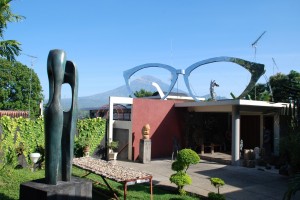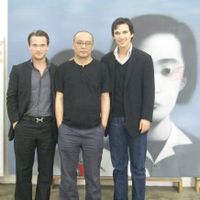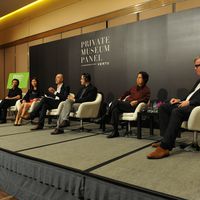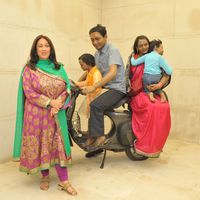Rethinking Museums | Oei Hong Djien Museum in Indonesia

[caption id="attachment_13951" align="alignright" width="300" caption="OHD museum"]
 [/caption]
[/caption]culture360.org contributor Bharti Lalwani presents the fourth in a series of interviews with Directors and Head Curators of Private Museums as well as Art Advisors to discuss the phenomenon of private art museums in Asia.
There is a shift occurring in the art world- more and more collectors are setting up their own private art museums in order to share their massive collections with the public. This rising trend, noted especially across India, China and Southeast Asia corresponds to active patronage and private education initiatives which are reinvigorating the local art scene in countries where the lack of gallery or museum infrastructure or government funding have a direct impact on artists and their practice.
Dr. Oei Hong Djien, is that rare collector who has been consistently collecting Indonesian art during the last three decades. His massive collection, at the OHD Museum in Magelang, spans a hundred years highlighting Indonesian art progressing through the nation's colonial and post colonial history, beginning with paintings by Raden Saleh (1807-1880). There is a significant work of art in almost every corner, on every wall of his home which spills into his museum where even the fascade is designed by Widayat (b.1919), one of Indonesia's foremost modern artist.
An overview of his museum can be seen on: http://ohd-artmuseum.blogspot.com/
(Dr. Oei Hong Djien: OHD, Bharti: B)
B: Dr. Oei, you have built quite a collection of modern and contemporary Indonesian art, acquiring over a thousand works, how did you embark on this journey as a collector?
OHD: Actually I was very much interested in art when I was much younger and around 1965 or so I bought my first painting but I wasnt seriously collecting until thirty years ago when I started buying high value works of Affandi from the artist himself, even taking out monthly installments to pay for those paintings and this was thirty years ago!
At the time there were no auction houses, very few galleries existed and artists were putting up exhibitions on their own; no curators, no philosophy, no catalogues and of course very few collectors. And obviously if you were one of the only few collectors in the area, alot of artists, especially younger ones, would come to you since they needed support in terms of paying for their tuition fee, buying art materials and such.
B: Well exactly, in Indonesia where artists have not been supported by public funding or any sort of government initiatives, artists naturally have been depending almost exclusively on collectors such as yourself. So how do you see your role as well as that of other collectors in nurturing the career of local artists?
OHD: It is a bit complex. First of all, because our government doesn't care about building museums, if they have in the past, they are not well maintained and the art within is badly in need of conservation. So it is up to collectors like myself who must rescue works of value, and of course we don’t have local conservators, I have had to fly them in from overseas and that in itself needs alot of money! With those sort of constraints, I have to also make space for these new acquisitions in the museum and keep it open to the public.
Around the 80's, collectors, who were based mostly in Jakarta, collected the old masters such as Affandi, Hendra Gunawan, Sudjojono, Widayat, Lee Man Fong and European artists staying in Indonesia - who were still alive at the time. But the source of art works was in Jogja and I was very much in contact with the young artists there and urged these collectors to buy current Indonesian art and support the local artists; How else would Indonesian art continue to flourish? Afterall there should be successors to the old masters and it is up to us to continue our patronage, but they weren't interested...
B: Why so?
OHD: Because the contemporary was incomprehensible, works by the Jendala Group for example were something completely new which they did not understand, so a few friends and myself continued buying newer and younger art. Then came the auction houses around the mid 90's, Christies followed by Sotheby's, in Singapore. When Sotheby's asked me to write an essay for one of their old master catalogues, I encouraged them to promote some of the newer names as well but they refused as according to them, that was the job of the galleries.
B: But there werent many galleries, professional enough, to guide and build the market for young artists in the first place.
[caption id="attachment_13952" align="alignright" width="198" caption="Dr. Oei with one of Hendra Gunawan's paintings"]
 [/caption]
[/caption]OHD: Exactly, at the time I even offered to help the auction houses in this matter but they simply were not interested and its funny to see that when Indonesian contemporary art boomed (in 2007 following the Chinese contemporary wave), those very auction houses preferred to bypass the galleries and auction works straight from the artists studios while even dictating how and what the artist should paint. It was a crazy time when everything was selling, galleries had sold-out shows and people were ready to pay the high prices. It was however, not a healthy environment for young artists. When the bubble burst not long after, few of those names have survived. So that should be a good lesson for galleries, for artists, and especially for collectors.
B: So through your continued patronage you are very much preserving local history in the making.
OHD: Yes infact we have lost many works of art through decades, especially after the Japanese invasion of Indonesia in 1942. Some works I recovered through other collectors or dealers were badly in need of conservation as they were burnt or badly damaged. About 45 paintings of Sudjojono were burnt during the revolution time in Jogja.
B: You once mentioned to me that you only collect Indonesian art as a rule.
OHD: Yes I do, but even that is a challenge as I dont have enough funds, enough space, enough time, or enough knowledge of art across Indonesia as it is so wide! I dont even go so far as to collect tradition Balinese art so I keep it to just modern and contemporary. Even starting off as a collector I had to really educate myself as there were no books written on Indonesian art history for my reference. You'll find one-off articles in magazines or so but after that you need to conduct your own research and learn through observation and experience. Infact I myself have been writing and curating exhibitions at my museum.
B: As a collector of local art your challenges have then been to educate yourself and to find and conserve old masterpieces...
OHD:...and making new discoveries! Discovering young, still unknown artists and old forgotten artists, both are of the same importance in terms of illuminating our history.
I have in my collection works which other collectors have never come across before such as the revolution paintings by Soedibio from the late 40’s which are very surrealist in manner.
B: So how did you go from being a collector to opening a private museum- was it the next logical step, a natural transition?
OHD: Actualy I had no intention at all of building a museum, infact when I started collecting paintings I did not even consider myself a “collector”; I was just someone who did not like living with empty walls. However the situation was such that I turned into an addictive collector, especially because of my close relations with the artists who are mainly from Jogja which is so close to Magelang where I have lived. It was really these artists who pushed me to build a space where my collection can be viewed from a curated perspective. One cannot be a collector if one cannot display their collection within the appropriate context. For a long time I did not have the funds to build a space, infact I used to buy paintings from borrowed money and focused more on having a well equipped storage space and conservation. As for the museum that now stands as an extension of my home, we bought a small house next to our back yard, broke it down and built the museum from scratch.
B: And obviously, the concept of a “museum” does not have be based on the western model, it does not have to be grandiose in any way, nor does it have to be a stagnant repository for objects, how do you keep your collection relevant and dynamic?
OHD: Once I built a commited space for my collection, my approach to collecting changed as well. Before I used to buy paintings without much consideration, but once I had a museum, I felt a responsibility towards buying with a bit more discretion- Does the art work have a historical significance? Does it fit well into my collection? Does it add value to what I already have?
Once I had a museum I had to have works which showed the development of the artist through his crucial and formative years such as Masriadi’s paintings from 1999 to 2006, Hendra Gunawan from the revolution time to the works he painted while in prison and after his release. So having the museum changed my collecting preferences and became more focused. For example, I was offered small drawings and sketches by Hendra Gunawan, Sudjojono, Kartono Yudhokusumo and others in very bad condition which therefore had no commercial value but to me they had a significance- they were of “museum value”. This demonstrates how my museum has now become the most comprehensive documentation of our Indonesian cultural history.
At first alot of people laughed at my small low cost “museum” building but over the years, so many visitors from all over the world have said that my collection is the best they have seen in Indonesian art, so this affirms that the most important thing is the collection itself, the content, and not necessarily an expensive “world class building”.
B: And you are using the collection as a medium by which to educate the community on their history.
OHD: I am always in touch with the local schools, from elementary to graduates who come from not only Magelang but from beyond the region. Museums curators from around the world also regularly visit. In fact a number of art professionals who want to learn about Indonesian art begin their orientation here and I always try to provide a space for research and study.
B: You also support other museums and public institutions overseas.
OHD: Yes, in the past I have lent works to several museum exhibitions on Indonesian art in Singapore, Holland and Korea, among other exhibitions in Japan, Hong Kong, Finland and Australia. I am now advisor to The National Art Gallery of Singapore for Indonesian art. Before I was board member of Singapore Art Museum after being as Honorary advisor for two periods.
B: You are also building a new space for your collection by converting one of your tobacco barracks into a museum space which will be complete by April 2012?
OHD: Yes, that space, will house temporary exhibitions from my collection. I intend to curate retrospectives of Hendra or Sudjojono, or Widayat, or have thematic exhibitions on portraiture and imagined landscapes among other themes. Or even invite proposals from other curators and sponsor their exhibitions, and use the space as a venue for artistic and cultural discourse. I will also be launching a book with comprehensive writings, lectures, essays that I have done over the last twenty years. I wont be the Director of that museum, my daughter in law will manage that instead. I will just be a curator selecting works for future exhibtions.
B: Will you be hosting international exhibitions as well?
OHD: We are not that far yet, but frankly, bringing in international works of art would be extremely expensive plus bearing in mind all the tax and customs hassles make things very complicated. Ofcourse we want to develop things but at our own pace. We dont want to make too ambitious programs which wouldnt be feasable, choosing instead to sustain and maintain our focus.
Bharti Lalwani has a BA in Fine Art and an MA in Contemporary Art; She writes for several publications across SE Asia and India.
Similar content
17 May 2011
30 Jan 2012
20 May 2011
posted on
22 Sep 2011





